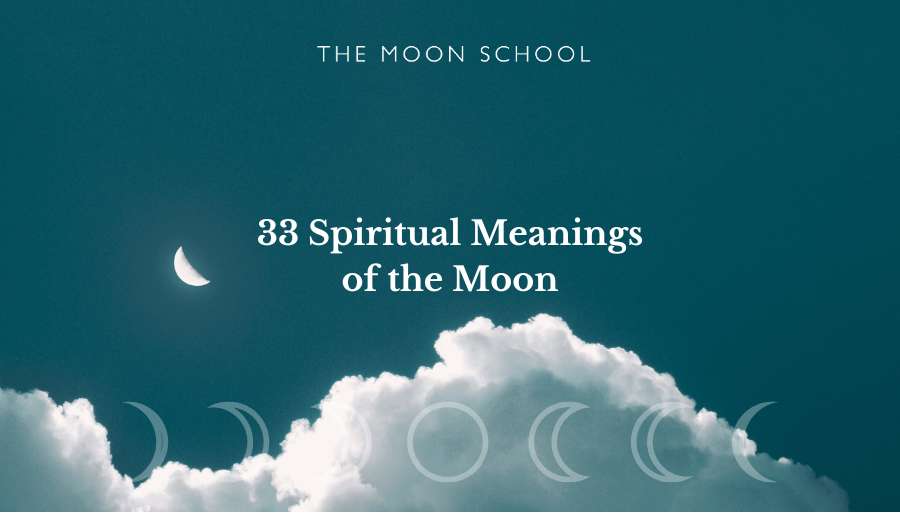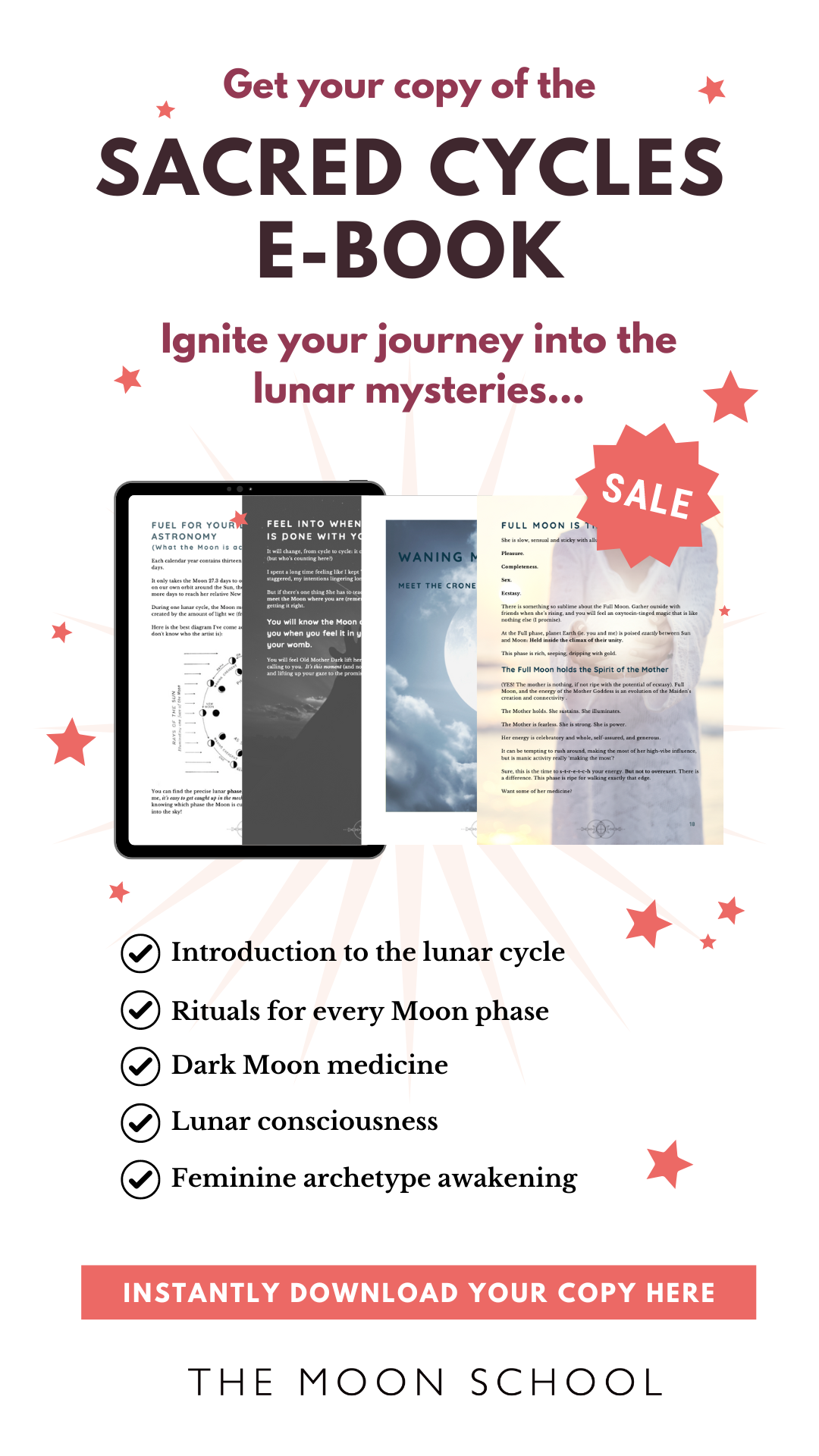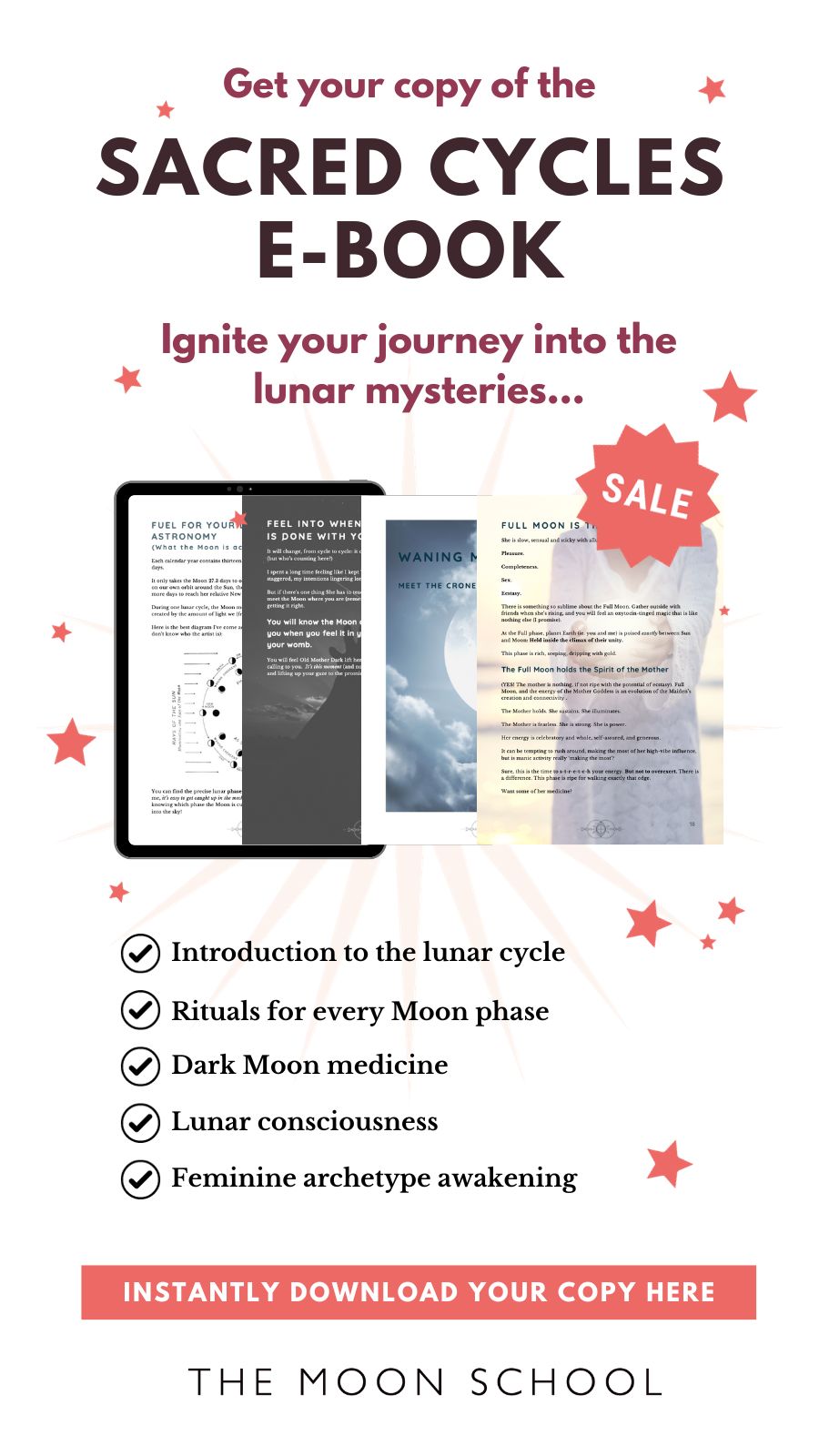Moon symbolism and the spiritual significance that humanity has given to the Moon crosses cultures, histories, and mythologies.
The depth of meaning that we have spent millennia attaching to Old Grandmother Moon forms a tapestry that is rich and holds us in rhythmic safety, rocking us to sleep on Moonlit nights, like babies.
What does the Moon symbolize to you? We each lend la Luna our own unique spiritual significance, yet certain spiritual meanings live collectively in our bones, universally understood. Here are 33 of them…
1. Cycles and rhythms of life
The different phases of the Moon all have spiritual meanings of their own, yet together they form a blueprint of the cycles and rhythms of life.
The eight phases of the Moon are:
- New moon
- Waxing crescent Moon
- First quarter Moon
- Waxing gibbous Moon
- Full Moon
- Waning gibbous Moon
- Last quarter Moon
- Waning crescent Moon
- Dark Moon
.. And together these Moon phases represent the natural ebb and flow of existence. The waxing and waning of the Moon reflects the cyclical nature of life, with its periods of growth, culmination, release, and renewal.
Embracing the Moon’s rhythmic energy encourages individuals to recognize the ever-changing patterns within their lives, fostering a deeper understanding of the interconnectedness between personal growth, natural cycles, and the universal flow of existence.
This symbolism invites seekers to align with the inherent rhythms of life, embrace change, and find harmony within the perpetual dance of creation and transformation.
2. Transformation and rebirth
Through the miraculous entirety of the lunar cycle, the Moon becomes a symbol of transformation and renewal.
Almost at the end of the lunar cycle, the waning crescent Moon becomes dark, disappearing completely into the sky. Then three days later, the new Moon emerges as a symbol of metamorphosis, renewal, and rebirth.
As you follow the phases of the Moon each month, from new to full and back again, you may realize that YOU mirror these same cycles of transformation in your own life. This beautiful and mysterious symbolism encourages us to embrace change, release the old, and welcome new beginnings.
By aligning with the Moon’s transformative energy, seekers can cultivate resilience, adaptability, and a deeper understanding of the cyclical nature of personal growth. Embracing the moon’s transformative symbolism fosters a sense of empowerment, encouraging individuals to navigate life’s transitions with grace, courage, and an open heart.
3. Feminine energy
The Moon is a timeless spiritual symbol of divine feminine energy for so many reasons. Her cyclical nature mirrors the menstrual cycles of women and the monthly changes that women’s bodies, energy, creativity, and emotions all move through.
Also read: Your Sacred Blood – What are the White and Red Moon Cycles?
As a feminine symbol, the Moon represents the main four female archetypes of maiden, mother, enchantress, and Crone, which are mirrored in the four main phases of waxing crescent moon, full Moon, waning Moon, and dark, or disseminating Moon.
In her triptych form of waxing crescent moon, full Moon, and waning crescent Moon, the triple Moon also represents the three core phases of womanhood – maiden, mother, and crone.
Often revered as a symbol of the feminine principle, the Moon seems to embody receptivity, intuition, and emotional depth, as well as the dark, wild, mysterious qualities that emerge under the waning Moon.
4. Reflection and introspection
In spiritual practice, the Moon is a symbol of self-reflection and introspection, appearing as a metaphor for inner contemplation and self-examination.
Just as the Moon reflects the light of the sun, we are encouraged to contemplate our own light and dark aspects.
After the peak of the full Moon phase, as the waning gibbous moon arrives and light dims, we are encouraged to go within and explore our own shadowlands. The Moon shows us that introspection is a natural and necessary part of growth and an intrinsic part of the cycles of creation.
5. Illumination
The illumination of the full Moon phase is beautifully symbolic of the emotional illumination we receive during this part of the Moon cycle.
The full Moon serves as a spotlight for our self-inquiry, lighting up parts of ourselves that we may have previously hidden.
6. Setting intentions
The spiritual meaning of the new Moon pertains to new beginnings, making it the ideal time to set intentions. This is when lunar energy is at its lowest, so has the most potential.
Before the waxing Moon phases arrive, we’re encouraged to focus on what we want and get purposeful when setting intentions for the lunar cycle. Then as the waxing crescent, first quarter Moon and waxing gibbous Moon phases arrive, our intentions RISE with the momentum of the lunar phases, manifesting at the full Moon (in theory!)
7. Cleansing and renewal
There’s a lot of Moon symbolism around cleansing and renewing, especially the waning Moon phases.
After the peak of the full Moon, as the Moon appears to ebb into darkness, it’s perceived as a purifying force that facilitates emotional and spiritual renewal. Just as the Moon influences the tides, it is believed to cleanse and refresh the spirit.
This cleansing, clarifying symbolism encourages individuals to release emotional burdens, negative energies, and stagnant patterns, allowing for inner purification and rejuvenation.
8. Connection to the subconscious mind
The Moon’s spiritual meaning has long been connected to the subconscious mind, as it can serve as a bridge to the depths of the psyche and the realm of intuition. The Moon’s gentle, receptive energy is often associated with the subconscious, dreams, and the inner realms of the mind.
In astrology, the Moon affects and represents the emotions, instincts, impulses, and deepest desires of the unconscious – those parts of ourselves that we can’t quite touch, yet have the most significant impact on our daily lives.
Also read: What’s the Meaning of the Moon in Astrology
9. Spiritual guidance
For some people, Moon symbolism offers spiritual guidance.
Just as the Moon has guided travelers and explorers across landscapes, throughout history, Old Grandmother Moon also represents a source of guidance for navigating life’s journey.
This symbolism surrounding la Luna encourages individuals to trust their inner wisdom, cultivate intuition, and seek clarity in times of uncertainty. By aligning with the Moon’s guiding energy, seekers can find reassurance in their path, connect with their inner compass, and embrace the wisdom that illuminates their journey.
10. Emotions and sensitivity
The Moon spiritual meaning also pertains to emotions and sensitivity, which is reflected in its connection to the water, and the the ebb and flow of feelings.
Just as the Moon influences the tides, it symbolizes the ever-changing landscape of emotions within us. This symbolism encourages acknowledging and honoring one’s emotional landscape, fostering empathy, and embracing the depth of sensitivity.
11. The great mystery
The enigmatic nature of the seemingly neverending lunar cycles makes it symbolic of the great mystery of life. The Moon has long been associated with the esoteric, and otherworldly aspects of existence.
This lunar symbolism encourages us to embrace the unknown, explore the depths of the mystical, and connect with the profound sense of wonder that permeates life.
12. Inner wisdom and intuition
Just as the Moon illuminates the night sky, it represents the light of inner wisdom that shines within each of us. As the Moon moves through her phases, we are encouraged seekers to trust their intuition, cultivate inner knowing, and seek guidance from the depths of their being.
13. Receptivity
The Moon receives the light of the Sun across its surface all the time. We may see this as more than half or less than half being illuminated depending on the phase of the Moon (which is determined by Sun, Moon, and Earth’s positions). Yet the Moon continues to receive and is perpetually open.
This spiritual symbolism invites us to also embrace a state of receptivity, allowing for the flow of intuitive insights, emotional connections, and spiritual guidance.
14. Balance of light and dark
The Moon symbolizes balance, through the perpetual dance of light and dark across her surface.
During the first quarter Moon, light and dark are equal until light overtakes, and the waxing gibbous Moon moves in.
During the last quarter Moon, again, light and dark fall equally across the Moon’s surface, but this time the darkness will prevail, as the waning crescent Moon returns.
This symbolism teaches us that balance is an ever-moving target. By embracing the Moon’s own spiritual meaning of balance, we’re able to experience a greater range of what balance actually means.
15. Creativity
Many spiritual practices adopt the Moon as a symbol of creativity. This is because the Moon brings rhythm to the process of creation, providing a map to follow. Yet la Luna has more than just symbolic meaning in this case – the Moon has been a muse for artists, poets, and writers for many centuries, inspiring great works of art that have touched countless hearts.
16. Release and letting go
Once the Moon reaches its peak and begins to wane, it becomes a powerful symbol of release. Many people hold Moon rituals to harness this lunar energy of letting go, fostering closure, and expediting the process of shedding that which no longer serves.
17. Adaptability and flexibility
The Moon cycle symbolizes adaptability and flexibility due to its transitions through the phases, modeling the ever-changing nature of life.
As our ever-present celestial companion, la Luna’s symbolism encourages us to embody qualities of flexibility, resilience, and openness to new experiences.
18. Healing
Spiritually, the Moon symbolizes healing and particularly emotional restoration, and comfort.
For many people, the constant of the Moon phases, and her gently rhythmic nature represent the soothing balm of emotional and spiritual healing.
Whether through the bright, illuminating glow of the full Moon, or the promise held in the new Moon phase, seekers have been able to cultivate a sense of emotional well-being and find comfort in times of distress, by embracing the Moon’s transformative power.
19. Motherhood
Old Grandmother Moon has offered a maternal influence for millennia.
This maternal symbolism likely stems from the Moon’s association with nurturing, cyclicality, and the divine feminine. Its gentle glow evokes a comforting presence, akin to a mother’s embrace. And across cultures, the Moon is revered as a symbol of fertility, emotional intuition, and maternal care.
The Moon’s soft radiance and cyclical nature evoke the timeless archetype of the mother, embodying compassion, empathy, and the sustaining power of the feminine.
20. Timelessness and eternity
The Moon symbolizes timelessness due to its unchanging presence throughout human history, representing a timeless constant in the ever-shifting tapestry of the cosmos.
The seemingly unending phases of the Moon evoke the eternal rhythms of existence. As a celestial body that transcends individual lifespans and human constructs of time, the Moon embodies a sense of permanence and continuity, evoking the timeless and eternal nature of the universe.
21. Fertility
In the ancient past, before artificial light and hormonal contraception, the Moon’s influence over the menstrual cycles of women formed its association with fertility.
The Moon’s radiant presence has also long been linked to the flourishing of life, agricultural cycles, and the bountiful harvest, granted by the Goddess and the generous, life-giving forces that shape the world.
22. Abundance
The waxing Moon phases reflect the, in which light and energy increase, are mirrors for the abundance of the natural world. The full Moon rising in the night sky offers a bounteous symbol of generosity, prosperity, and the harvest that inevitably comes from hard work.
23. Protection and comfort
Across cultures, the Moon has been revered as a protective force, providing guidance and comfort during times of uncertainty.
The waxing crescent phase will always emerge from the new Moon.
The waning gibbous will always follow the full Moon.
Through its steadfast presence in the night sky, the different phases of the Moon serve as beacons of reassurance, making it a powerful symbol of protection and comfort during life’s challenges.
24. Connection to the Goddess
The Moon symbolizes a connection to the divine feminine through its association with the cycles of creation and destruction.
Revered over millennia as not just a representation, but the embodiment of the Goddess, the Moon has become a symbol of the Goddess herself, and all the aspects she holds.
From the nurturing mother to the wild woman, to the devourer, different phases reflect the sacred, Goddess-given rhythms of womanhood.
25. Psychic abilities
For some, the Moon has become a powerful symbol of our psychic abilities, through its association with intuition, mystery, and the unseen realms. The Moon has long been linked to heightened sensitivity and inner knowing, inspiring a deep connection to the intuitive faculties of the human psyche.
Also, as a symbol of mystery and intuition, the Moon serves as a potent source of inspiration for the exploration and development of psychic abilities, encouraging individuals to trust their inner wisdom and embrace the ethereal forces that shape their spiritual journey.
26. Dreamwork
Through its association with the subconscious and the exploration of inner landscapes, the Moon is one of our greatest symbols of the dreaming realms.
The Moon’s influence on the nocturnal realm inspires a deep connection to the world of dreams. It can feel like Grandmother Moon is encouraging us to delve into our innermost thoughts, emotions, and the symbolic imagery that lives there.
The shifting, fluid nature of the lunar phases also seems to echo the landscape of dreams, bridging the inner world with the outer, celestial realms.
27. Reflection on the soul’s journey
Human life is an ever-changing landscape of highs and lows, and the Moon seems to reflect this through her constant change.
Step outside under any Moon phase, look up, and her ethereal glow will inspire introspection and contemplation, inviting you to acknowledge the transformative power of life’s cycles.
As a profound symbol of inner knowledge and spiritual connection, the physical presence of the Moon encourages seekers to reflect on their own path, and the sacredness of the steps they are taking.
28. Unconscious desires and emotions
The Moon symbolizes unconscious desires and emotions due to its association with the hidden realms of the psyche and the depths of the subconscious.
Mirroring the veiled aspects of the human psyche, la Luna may also represent unacknowledged emotions, deep-seated desires, and the mysteries of the unconscious mind.
The Moon’s phases evoke the ever-changing landscape of emotions and the subtle undercurrents of desire, making it a potent symbol for exploring and understanding the complexities of the unconscious and delving into the depths of one’s emotional landscape.
29. Connection to the natural world
The Moon offers us a symbolic connection to the natural world through its influence on earthly phenomena, such as tides and agricultural cycles.
The Moon phases also reflect the rhythms that exist in wider nature, evoking a deep reverence for the interconnectedness of all life forms. As a symbol of nature’s rhythms and forces, the Moon may help us to foster a greater sense of ecological awareness, as well as spiritual attunement to the natural world.
30. The cycles of life
Through each Moon phase, la Luna symbolizes the cycles of life, representing the eternal rhythms of birth, growth, decay, and renewal. From new Moon to full, and back to new Moon, this rhythm mirrors the ebb and flow of existence, embodying the cyclical nature of life’s journey.
31. The shadow self
In its darker phases, the Moon is a potent symbol of the shadow self due to its association with the subconscious, hidden emotions, and the depths of the psyche.
Displaying the interplay of light and darkness, la Luna serves as a mirror for the complexities of the human psyche, and also offers us multiple opportunities to explore the depths of our darkness.
It’s ever-changing appearance evokes the fluidity of the shadow self, representing unacknowledged emotions, unresolved aspects of the self, and the need for introspection, making it a potent symbol for delving into the depths of the unconscious.
32. Lunar deities and mythology
The Moon has played a central role in ancient cosmologies, religious beliefs, and mythic narratives for many centuries.
A diverse range of cultures has revered the Moon as a divine entity, embodying the mysteries of the sacred feminine, cycles of creation, and magic of unseen realms.
33. Magic and the occult
The Moon is a symbol of magic and the occult due to its association with the unseen, ethereal forces that shape existence.
Its enigmatic influence has long been linked to the veiled mysteries of the universe, symbolizing the enchanting allure of the unknown and the transformative power of magic.
The Moon’s phases and celestial presence evoke a sense of mystical wonder, making it a potent symbol in esoteric traditions, occult practices, and the exploration of metaphysical realms.




